Analyzing Reward System Effects on Hilton Employee Performance
VerifiedAdded on 2022/12/28
|46
|12856
|45
Report
AI Summary
This report investigates the effects of reward systems on employee performance within the hospitality industry, using Hilton as a case study. The research explores the concept of reward systems, differentiating between extrinsic and intrinsic rewards and their impact on employee motivation and productivity. It examines various types of reward systems, including compensation, benefits, and recognition programs, and analyzes their influence on employee behavior and organizational outcomes. The study identifies potential barriers and challenges that Hilton faces in implementing and managing reward systems, such as understanding diverse employee needs and selecting appropriate reward strategies. The methodology involves gathering secondary information from books, articles, and journals, and primary data through questionnaires administered to Hilton employees. The findings are presented with the assistance of graphs and interpreted to offer recommendations for improving reward system effectiveness, including strategies to enhance employee engagement, retention, and overall performance. The report aims to provide valuable insights into the role of reward systems in fostering a positive work environment and achieving organizational goals within the competitive hospitality sector.
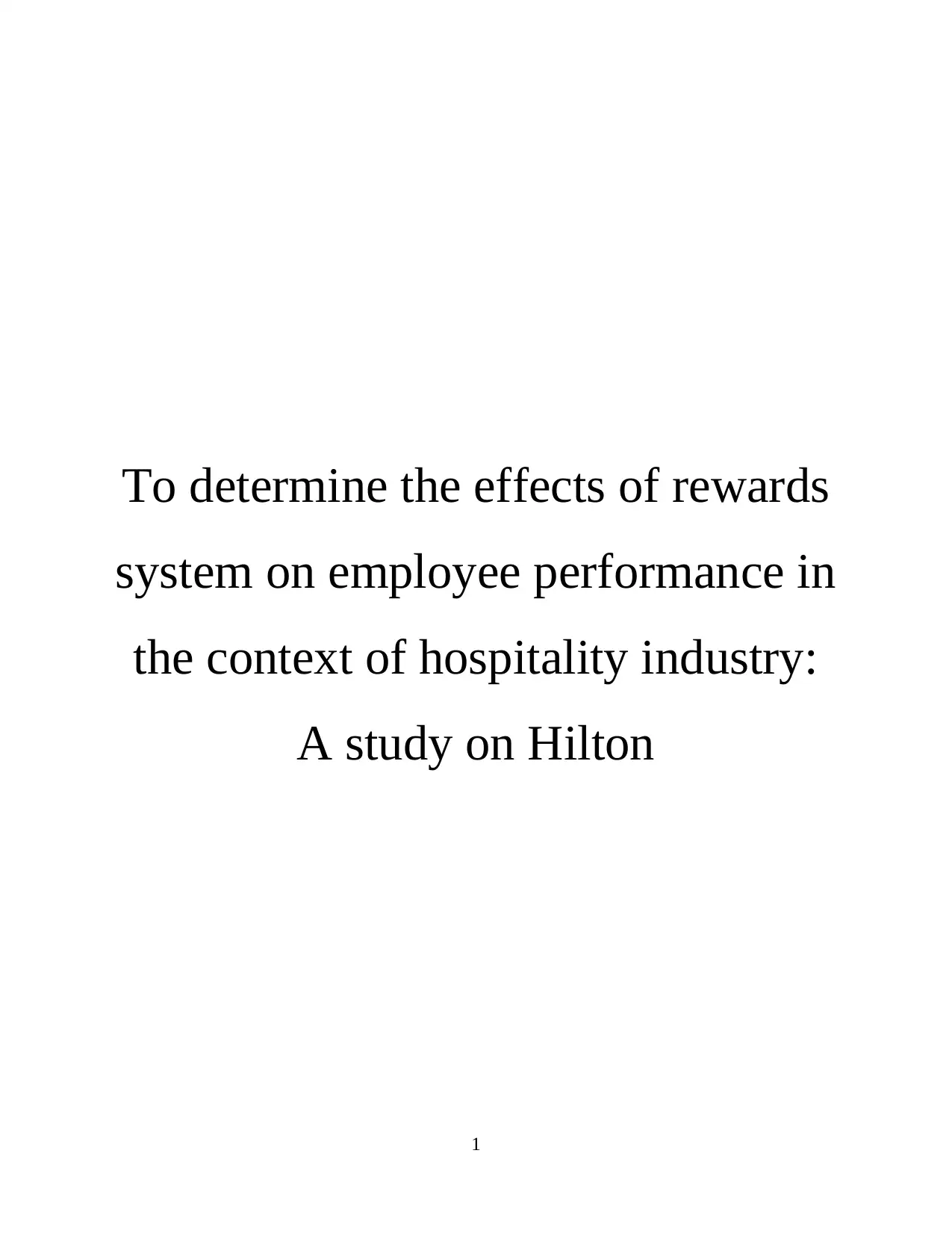
To determine the effects of rewards
system on employee performance in
the context of hospitality industry:
A study on Hilton
1
system on employee performance in
the context of hospitality industry:
A study on Hilton
1
Paraphrase This Document
Need a fresh take? Get an instant paraphrase of this document with our AI Paraphraser
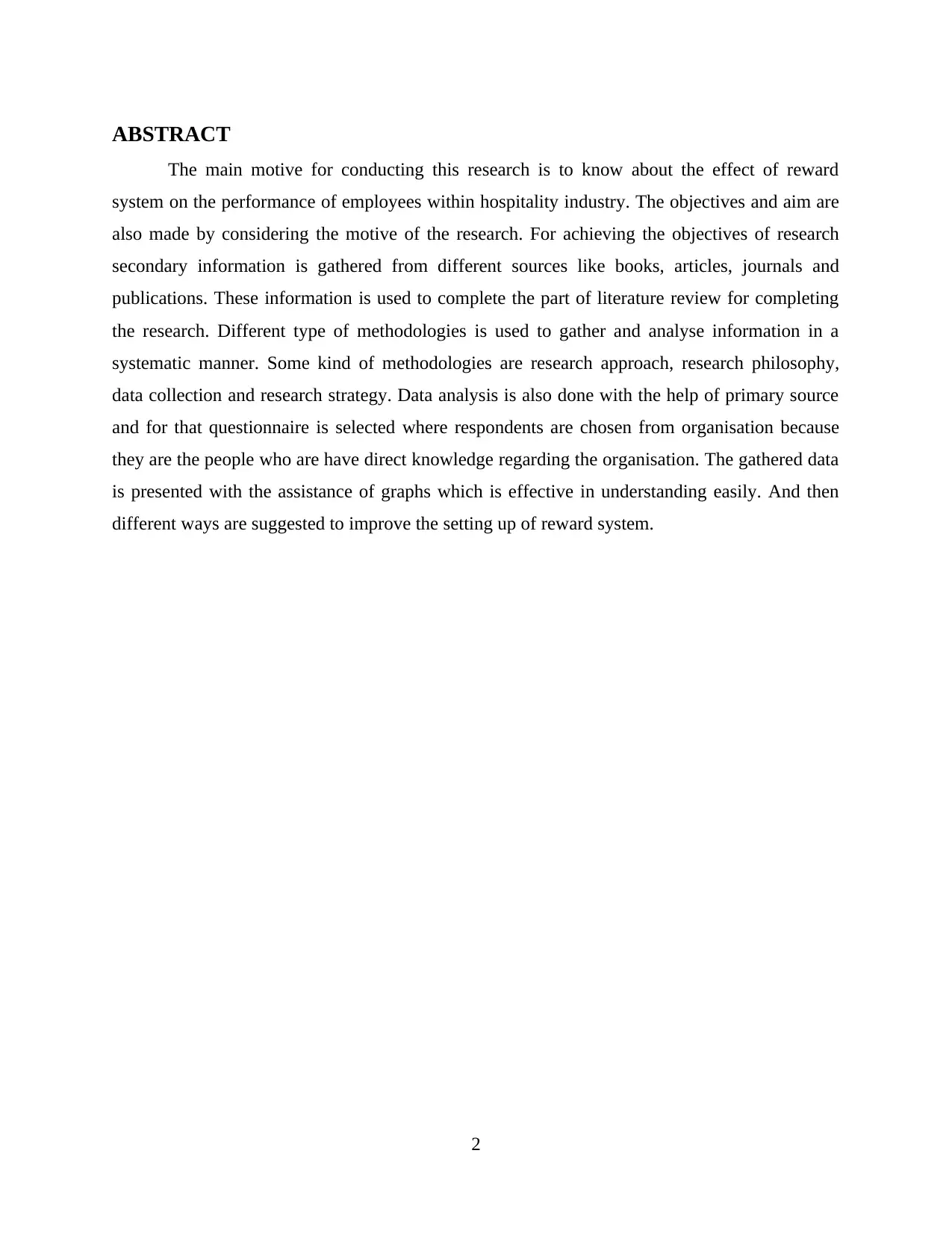
ABSTRACT
The main motive for conducting this research is to know about the effect of reward
system on the performance of employees within hospitality industry. The objectives and aim are
also made by considering the motive of the research. For achieving the objectives of research
secondary information is gathered from different sources like books, articles, journals and
publications. These information is used to complete the part of literature review for completing
the research. Different type of methodologies is used to gather and analyse information in a
systematic manner. Some kind of methodologies are research approach, research philosophy,
data collection and research strategy. Data analysis is also done with the help of primary source
and for that questionnaire is selected where respondents are chosen from organisation because
they are the people who are have direct knowledge regarding the organisation. The gathered data
is presented with the assistance of graphs which is effective in understanding easily. And then
different ways are suggested to improve the setting up of reward system.
2
The main motive for conducting this research is to know about the effect of reward
system on the performance of employees within hospitality industry. The objectives and aim are
also made by considering the motive of the research. For achieving the objectives of research
secondary information is gathered from different sources like books, articles, journals and
publications. These information is used to complete the part of literature review for completing
the research. Different type of methodologies is used to gather and analyse information in a
systematic manner. Some kind of methodologies are research approach, research philosophy,
data collection and research strategy. Data analysis is also done with the help of primary source
and for that questionnaire is selected where respondents are chosen from organisation because
they are the people who are have direct knowledge regarding the organisation. The gathered data
is presented with the assistance of graphs which is effective in understanding easily. And then
different ways are suggested to improve the setting up of reward system.
2
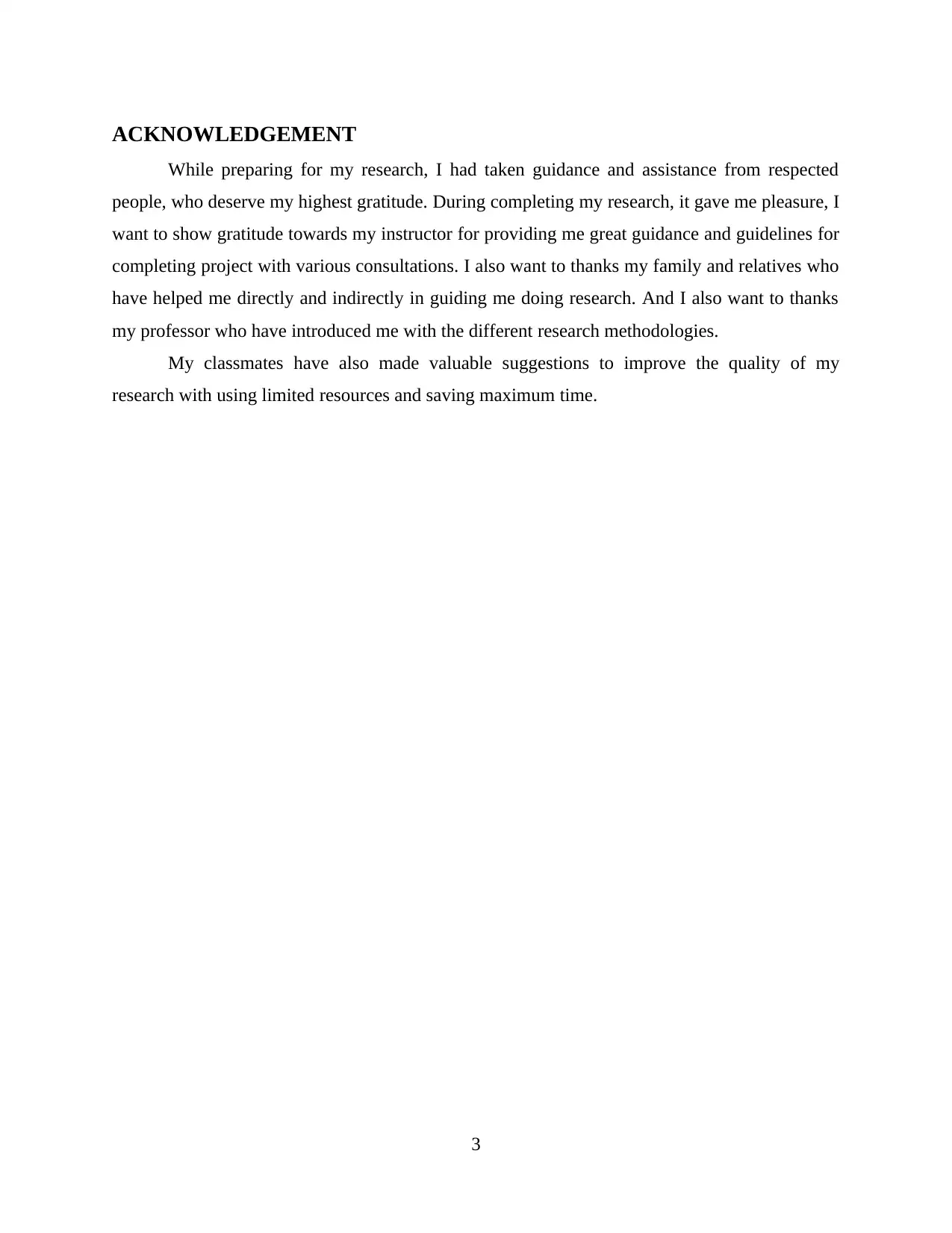
ACKNOWLEDGEMENT
While preparing for my research, I had taken guidance and assistance from respected
people, who deserve my highest gratitude. During completing my research, it gave me pleasure, I
want to show gratitude towards my instructor for providing me great guidance and guidelines for
completing project with various consultations. I also want to thanks my family and relatives who
have helped me directly and indirectly in guiding me doing research. And I also want to thanks
my professor who have introduced me with the different research methodologies.
My classmates have also made valuable suggestions to improve the quality of my
research with using limited resources and saving maximum time.
3
While preparing for my research, I had taken guidance and assistance from respected
people, who deserve my highest gratitude. During completing my research, it gave me pleasure, I
want to show gratitude towards my instructor for providing me great guidance and guidelines for
completing project with various consultations. I also want to thanks my family and relatives who
have helped me directly and indirectly in guiding me doing research. And I also want to thanks
my professor who have introduced me with the different research methodologies.
My classmates have also made valuable suggestions to improve the quality of my
research with using limited resources and saving maximum time.
3
⊘ This is a preview!⊘
Do you want full access?
Subscribe today to unlock all pages.

Trusted by 1+ million students worldwide
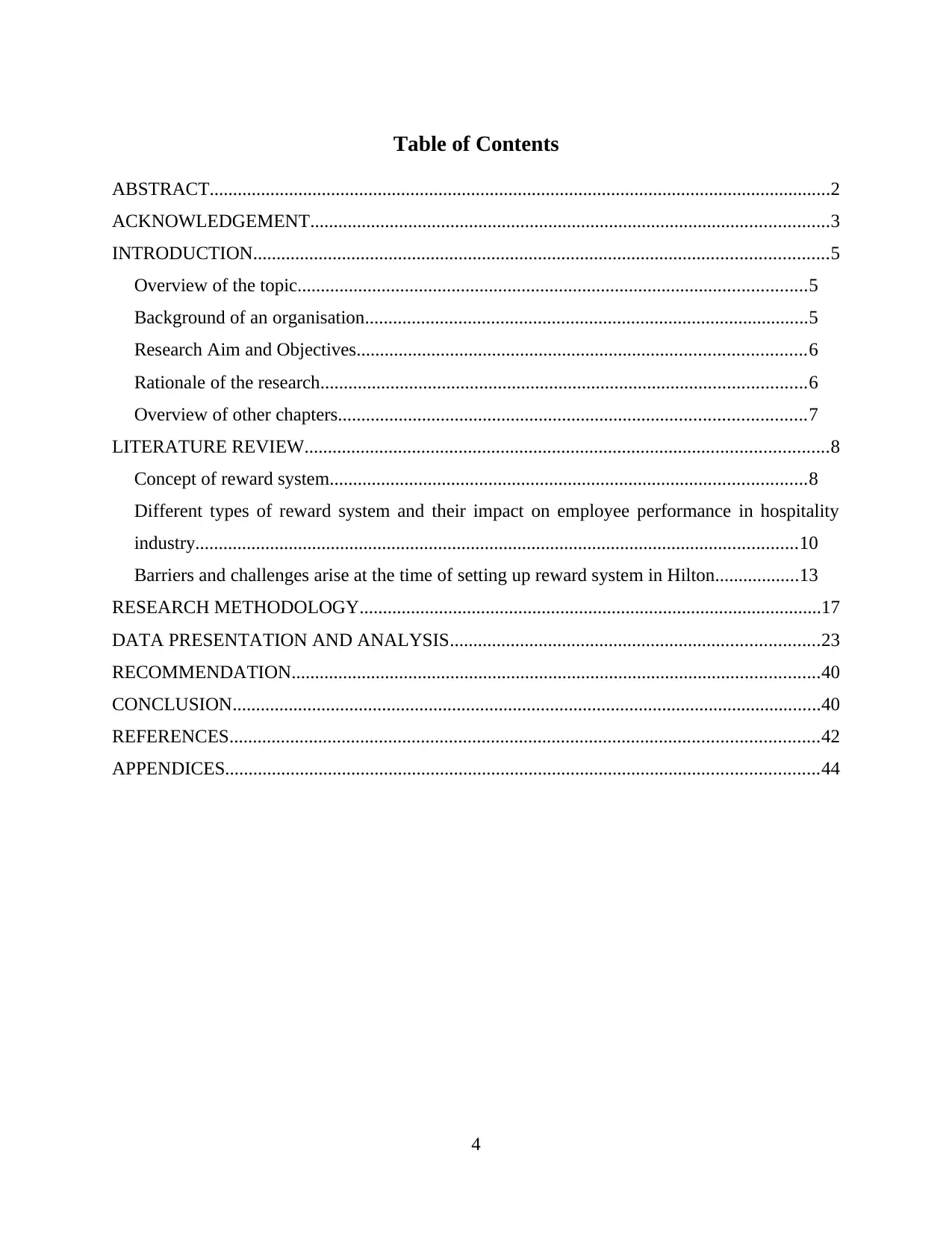
Table of Contents
ABSTRACT.....................................................................................................................................2
ACKNOWLEDGEMENT...............................................................................................................3
INTRODUCTION...........................................................................................................................5
Overview of the topic.............................................................................................................5
Background of an organisation...............................................................................................5
Research Aim and Objectives................................................................................................6
Rationale of the research........................................................................................................6
Overview of other chapters....................................................................................................7
LITERATURE REVIEW................................................................................................................8
Concept of reward system......................................................................................................8
Different types of reward system and their impact on employee performance in hospitality
industry.................................................................................................................................10
Barriers and challenges arise at the time of setting up reward system in Hilton..................13
RESEARCH METHODOLOGY...................................................................................................17
DATA PRESENTATION AND ANALYSIS...............................................................................23
RECOMMENDATION.................................................................................................................40
CONCLUSION..............................................................................................................................40
REFERENCES..............................................................................................................................42
APPENDICES...............................................................................................................................44
4
ABSTRACT.....................................................................................................................................2
ACKNOWLEDGEMENT...............................................................................................................3
INTRODUCTION...........................................................................................................................5
Overview of the topic.............................................................................................................5
Background of an organisation...............................................................................................5
Research Aim and Objectives................................................................................................6
Rationale of the research........................................................................................................6
Overview of other chapters....................................................................................................7
LITERATURE REVIEW................................................................................................................8
Concept of reward system......................................................................................................8
Different types of reward system and their impact on employee performance in hospitality
industry.................................................................................................................................10
Barriers and challenges arise at the time of setting up reward system in Hilton..................13
RESEARCH METHODOLOGY...................................................................................................17
DATA PRESENTATION AND ANALYSIS...............................................................................23
RECOMMENDATION.................................................................................................................40
CONCLUSION..............................................................................................................................40
REFERENCES..............................................................................................................................42
APPENDICES...............................................................................................................................44
4
Paraphrase This Document
Need a fresh take? Get an instant paraphrase of this document with our AI Paraphraser
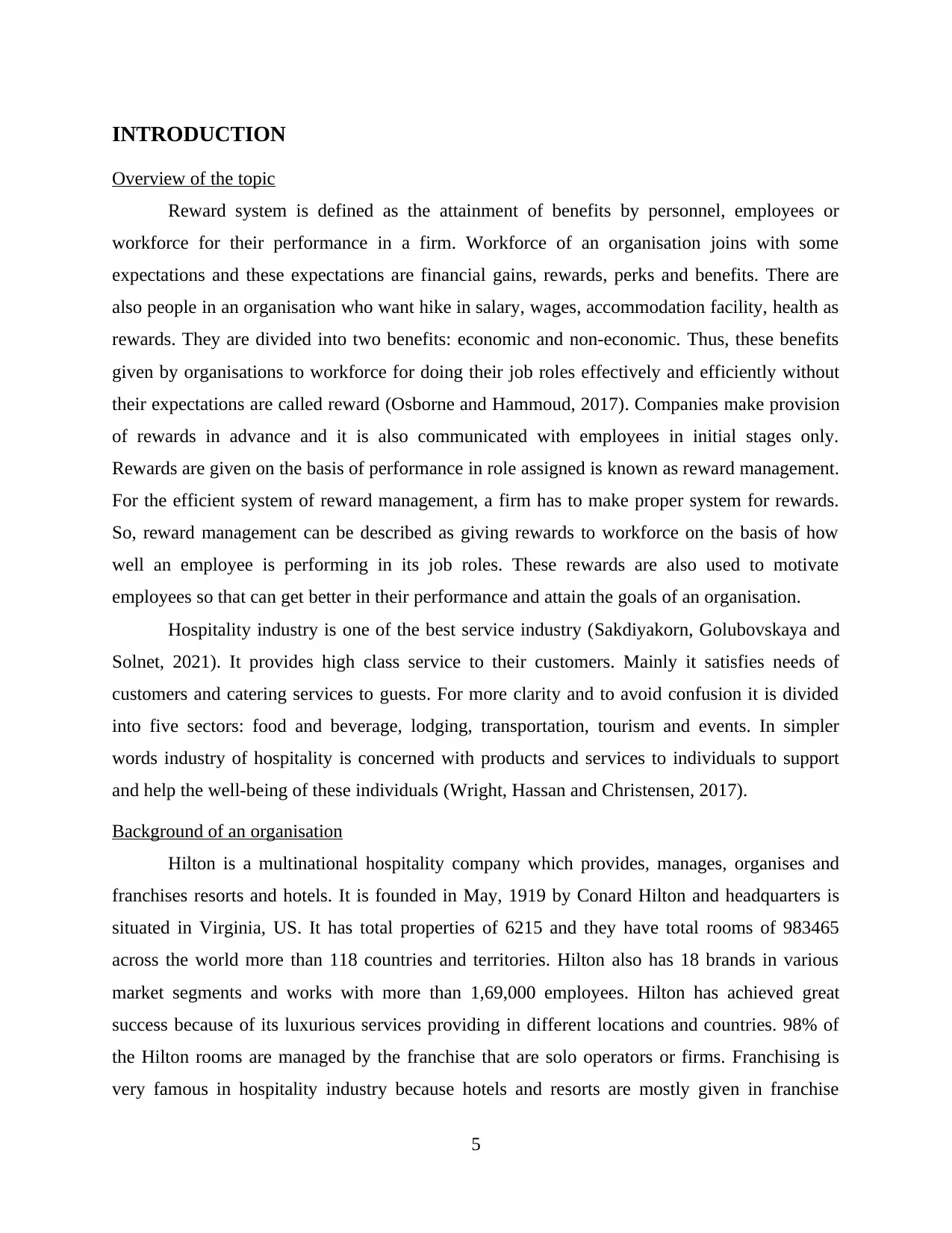
INTRODUCTION
Overview of the topic
Reward system is defined as the attainment of benefits by personnel, employees or
workforce for their performance in a firm. Workforce of an organisation joins with some
expectations and these expectations are financial gains, rewards, perks and benefits. There are
also people in an organisation who want hike in salary, wages, accommodation facility, health as
rewards. They are divided into two benefits: economic and non-economic. Thus, these benefits
given by organisations to workforce for doing their job roles effectively and efficiently without
their expectations are called reward (Osborne and Hammoud, 2017). Companies make provision
of rewards in advance and it is also communicated with employees in initial stages only.
Rewards are given on the basis of performance in role assigned is known as reward management.
For the efficient system of reward management, a firm has to make proper system for rewards.
So, reward management can be described as giving rewards to workforce on the basis of how
well an employee is performing in its job roles. These rewards are also used to motivate
employees so that can get better in their performance and attain the goals of an organisation.
Hospitality industry is one of the best service industry (Sakdiyakorn, Golubovskaya and
Solnet, 2021). It provides high class service to their customers. Mainly it satisfies needs of
customers and catering services to guests. For more clarity and to avoid confusion it is divided
into five sectors: food and beverage, lodging, transportation, tourism and events. In simpler
words industry of hospitality is concerned with products and services to individuals to support
and help the well-being of these individuals (Wright, Hassan and Christensen, 2017).
Background of an organisation
Hilton is a multinational hospitality company which provides, manages, organises and
franchises resorts and hotels. It is founded in May, 1919 by Conard Hilton and headquarters is
situated in Virginia, US. It has total properties of 6215 and they have total rooms of 983465
across the world more than 118 countries and territories. Hilton also has 18 brands in various
market segments and works with more than 1,69,000 employees. Hilton has achieved great
success because of its luxurious services providing in different locations and countries. 98% of
the Hilton rooms are managed by the franchise that are solo operators or firms. Franchising is
very famous in hospitality industry because hotels and resorts are mostly given in franchise
5
Overview of the topic
Reward system is defined as the attainment of benefits by personnel, employees or
workforce for their performance in a firm. Workforce of an organisation joins with some
expectations and these expectations are financial gains, rewards, perks and benefits. There are
also people in an organisation who want hike in salary, wages, accommodation facility, health as
rewards. They are divided into two benefits: economic and non-economic. Thus, these benefits
given by organisations to workforce for doing their job roles effectively and efficiently without
their expectations are called reward (Osborne and Hammoud, 2017). Companies make provision
of rewards in advance and it is also communicated with employees in initial stages only.
Rewards are given on the basis of performance in role assigned is known as reward management.
For the efficient system of reward management, a firm has to make proper system for rewards.
So, reward management can be described as giving rewards to workforce on the basis of how
well an employee is performing in its job roles. These rewards are also used to motivate
employees so that can get better in their performance and attain the goals of an organisation.
Hospitality industry is one of the best service industry (Sakdiyakorn, Golubovskaya and
Solnet, 2021). It provides high class service to their customers. Mainly it satisfies needs of
customers and catering services to guests. For more clarity and to avoid confusion it is divided
into five sectors: food and beverage, lodging, transportation, tourism and events. In simpler
words industry of hospitality is concerned with products and services to individuals to support
and help the well-being of these individuals (Wright, Hassan and Christensen, 2017).
Background of an organisation
Hilton is a multinational hospitality company which provides, manages, organises and
franchises resorts and hotels. It is founded in May, 1919 by Conard Hilton and headquarters is
situated in Virginia, US. It has total properties of 6215 and they have total rooms of 983465
across the world more than 118 countries and territories. Hilton also has 18 brands in various
market segments and works with more than 1,69,000 employees. Hilton has achieved great
success because of its luxurious services providing in different locations and countries. 98% of
the Hilton rooms are managed by the franchise that are solo operators or firms. Franchising is
very famous in hospitality industry because hotels and resorts are mostly given in franchise
5
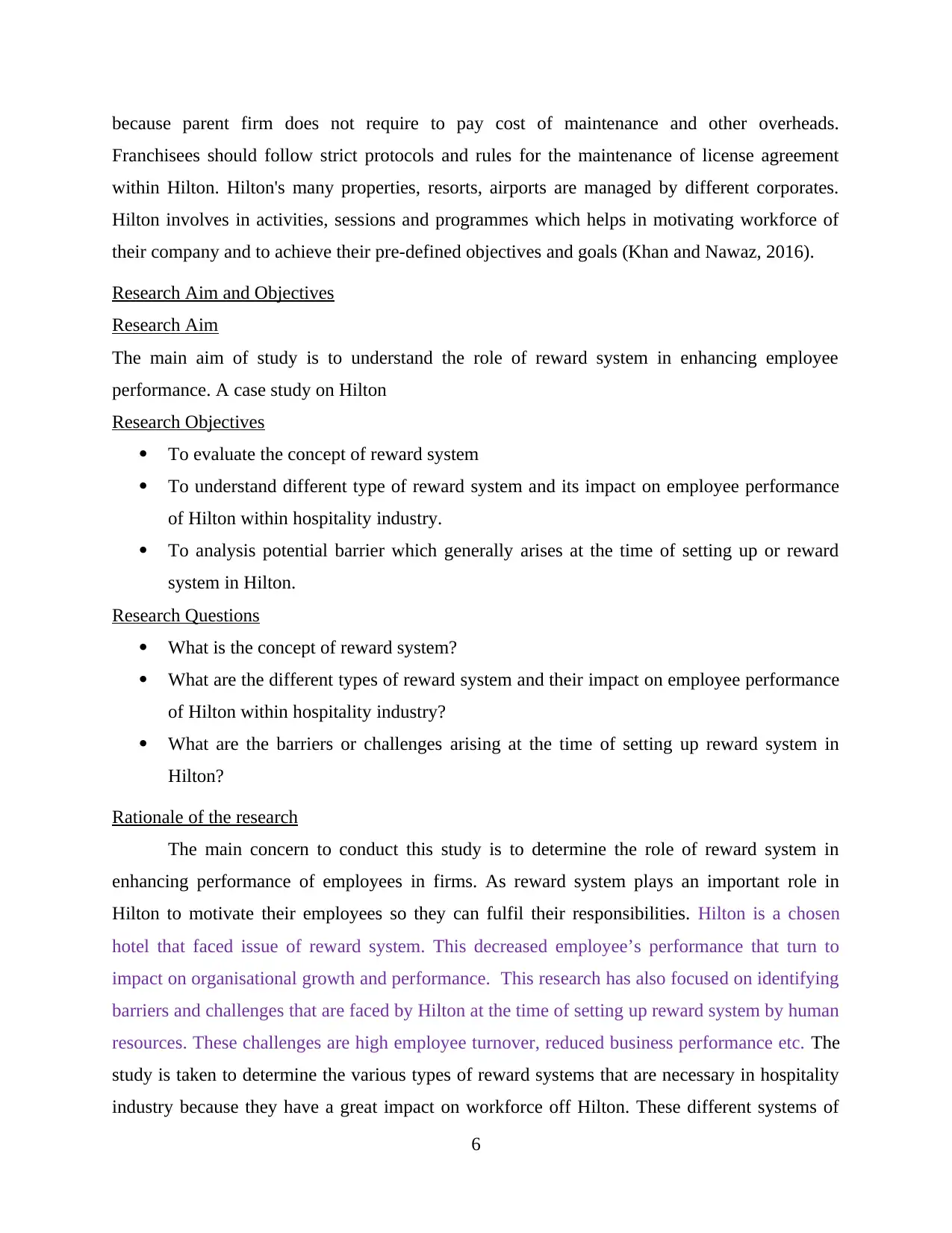
because parent firm does not require to pay cost of maintenance and other overheads.
Franchisees should follow strict protocols and rules for the maintenance of license agreement
within Hilton. Hilton's many properties, resorts, airports are managed by different corporates.
Hilton involves in activities, sessions and programmes which helps in motivating workforce of
their company and to achieve their pre-defined objectives and goals (Khan and Nawaz, 2016).
Research Aim and Objectives
Research Aim
The main aim of study is to understand the role of reward system in enhancing employee
performance. A case study on Hilton
Research Objectives
To evaluate the concept of reward system
To understand different type of reward system and its impact on employee performance
of Hilton within hospitality industry.
To analysis potential barrier which generally arises at the time of setting up or reward
system in Hilton.
Research Questions
What is the concept of reward system?
What are the different types of reward system and their impact on employee performance
of Hilton within hospitality industry?
What are the barriers or challenges arising at the time of setting up reward system in
Hilton?
Rationale of the research
The main concern to conduct this study is to determine the role of reward system in
enhancing performance of employees in firms. As reward system plays an important role in
Hilton to motivate their employees so they can fulfil their responsibilities. Hilton is a chosen
hotel that faced issue of reward system. This decreased employee’s performance that turn to
impact on organisational growth and performance. This research has also focused on identifying
barriers and challenges that are faced by Hilton at the time of setting up reward system by human
resources. These challenges are high employee turnover, reduced business performance etc. The
study is taken to determine the various types of reward systems that are necessary in hospitality
industry because they have a great impact on workforce off Hilton. These different systems of
6
Franchisees should follow strict protocols and rules for the maintenance of license agreement
within Hilton. Hilton's many properties, resorts, airports are managed by different corporates.
Hilton involves in activities, sessions and programmes which helps in motivating workforce of
their company and to achieve their pre-defined objectives and goals (Khan and Nawaz, 2016).
Research Aim and Objectives
Research Aim
The main aim of study is to understand the role of reward system in enhancing employee
performance. A case study on Hilton
Research Objectives
To evaluate the concept of reward system
To understand different type of reward system and its impact on employee performance
of Hilton within hospitality industry.
To analysis potential barrier which generally arises at the time of setting up or reward
system in Hilton.
Research Questions
What is the concept of reward system?
What are the different types of reward system and their impact on employee performance
of Hilton within hospitality industry?
What are the barriers or challenges arising at the time of setting up reward system in
Hilton?
Rationale of the research
The main concern to conduct this study is to determine the role of reward system in
enhancing performance of employees in firms. As reward system plays an important role in
Hilton to motivate their employees so they can fulfil their responsibilities. Hilton is a chosen
hotel that faced issue of reward system. This decreased employee’s performance that turn to
impact on organisational growth and performance. This research has also focused on identifying
barriers and challenges that are faced by Hilton at the time of setting up reward system by human
resources. These challenges are high employee turnover, reduced business performance etc. The
study is taken to determine the various types of reward systems that are necessary in hospitality
industry because they have a great impact on workforce off Hilton. These different systems of
6
⊘ This is a preview!⊘
Do you want full access?
Subscribe today to unlock all pages.

Trusted by 1+ million students worldwide
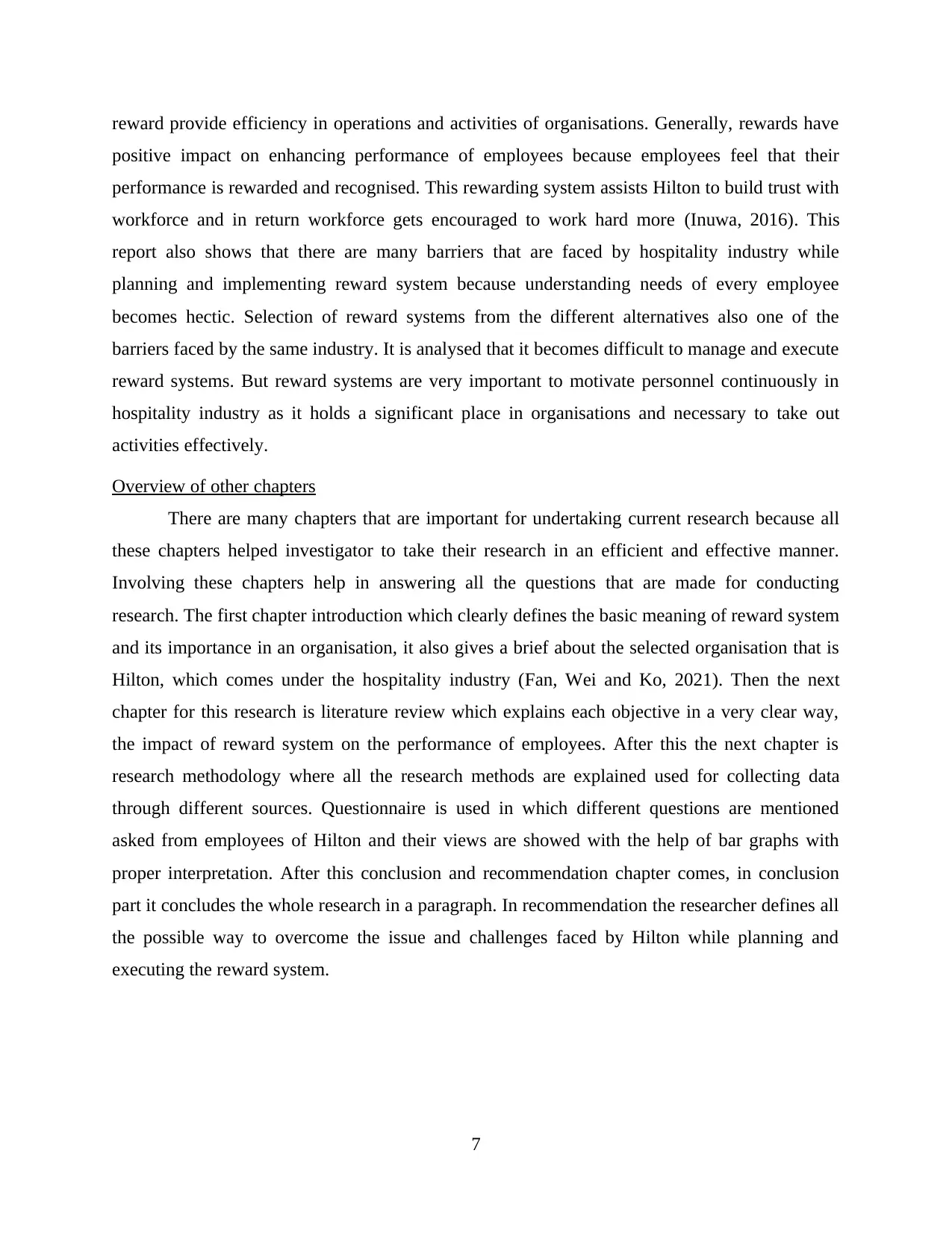
reward provide efficiency in operations and activities of organisations. Generally, rewards have
positive impact on enhancing performance of employees because employees feel that their
performance is rewarded and recognised. This rewarding system assists Hilton to build trust with
workforce and in return workforce gets encouraged to work hard more (Inuwa, 2016). This
report also shows that there are many barriers that are faced by hospitality industry while
planning and implementing reward system because understanding needs of every employee
becomes hectic. Selection of reward systems from the different alternatives also one of the
barriers faced by the same industry. It is analysed that it becomes difficult to manage and execute
reward systems. But reward systems are very important to motivate personnel continuously in
hospitality industry as it holds a significant place in organisations and necessary to take out
activities effectively.
Overview of other chapters
There are many chapters that are important for undertaking current research because all
these chapters helped investigator to take their research in an efficient and effective manner.
Involving these chapters help in answering all the questions that are made for conducting
research. The first chapter introduction which clearly defines the basic meaning of reward system
and its importance in an organisation, it also gives a brief about the selected organisation that is
Hilton, which comes under the hospitality industry (Fan, Wei and Ko, 2021). Then the next
chapter for this research is literature review which explains each objective in a very clear way,
the impact of reward system on the performance of employees. After this the next chapter is
research methodology where all the research methods are explained used for collecting data
through different sources. Questionnaire is used in which different questions are mentioned
asked from employees of Hilton and their views are showed with the help of bar graphs with
proper interpretation. After this conclusion and recommendation chapter comes, in conclusion
part it concludes the whole research in a paragraph. In recommendation the researcher defines all
the possible way to overcome the issue and challenges faced by Hilton while planning and
executing the reward system.
7
positive impact on enhancing performance of employees because employees feel that their
performance is rewarded and recognised. This rewarding system assists Hilton to build trust with
workforce and in return workforce gets encouraged to work hard more (Inuwa, 2016). This
report also shows that there are many barriers that are faced by hospitality industry while
planning and implementing reward system because understanding needs of every employee
becomes hectic. Selection of reward systems from the different alternatives also one of the
barriers faced by the same industry. It is analysed that it becomes difficult to manage and execute
reward systems. But reward systems are very important to motivate personnel continuously in
hospitality industry as it holds a significant place in organisations and necessary to take out
activities effectively.
Overview of other chapters
There are many chapters that are important for undertaking current research because all
these chapters helped investigator to take their research in an efficient and effective manner.
Involving these chapters help in answering all the questions that are made for conducting
research. The first chapter introduction which clearly defines the basic meaning of reward system
and its importance in an organisation, it also gives a brief about the selected organisation that is
Hilton, which comes under the hospitality industry (Fan, Wei and Ko, 2021). Then the next
chapter for this research is literature review which explains each objective in a very clear way,
the impact of reward system on the performance of employees. After this the next chapter is
research methodology where all the research methods are explained used for collecting data
through different sources. Questionnaire is used in which different questions are mentioned
asked from employees of Hilton and their views are showed with the help of bar graphs with
proper interpretation. After this conclusion and recommendation chapter comes, in conclusion
part it concludes the whole research in a paragraph. In recommendation the researcher defines all
the possible way to overcome the issue and challenges faced by Hilton while planning and
executing the reward system.
7
Paraphrase This Document
Need a fresh take? Get an instant paraphrase of this document with our AI Paraphraser
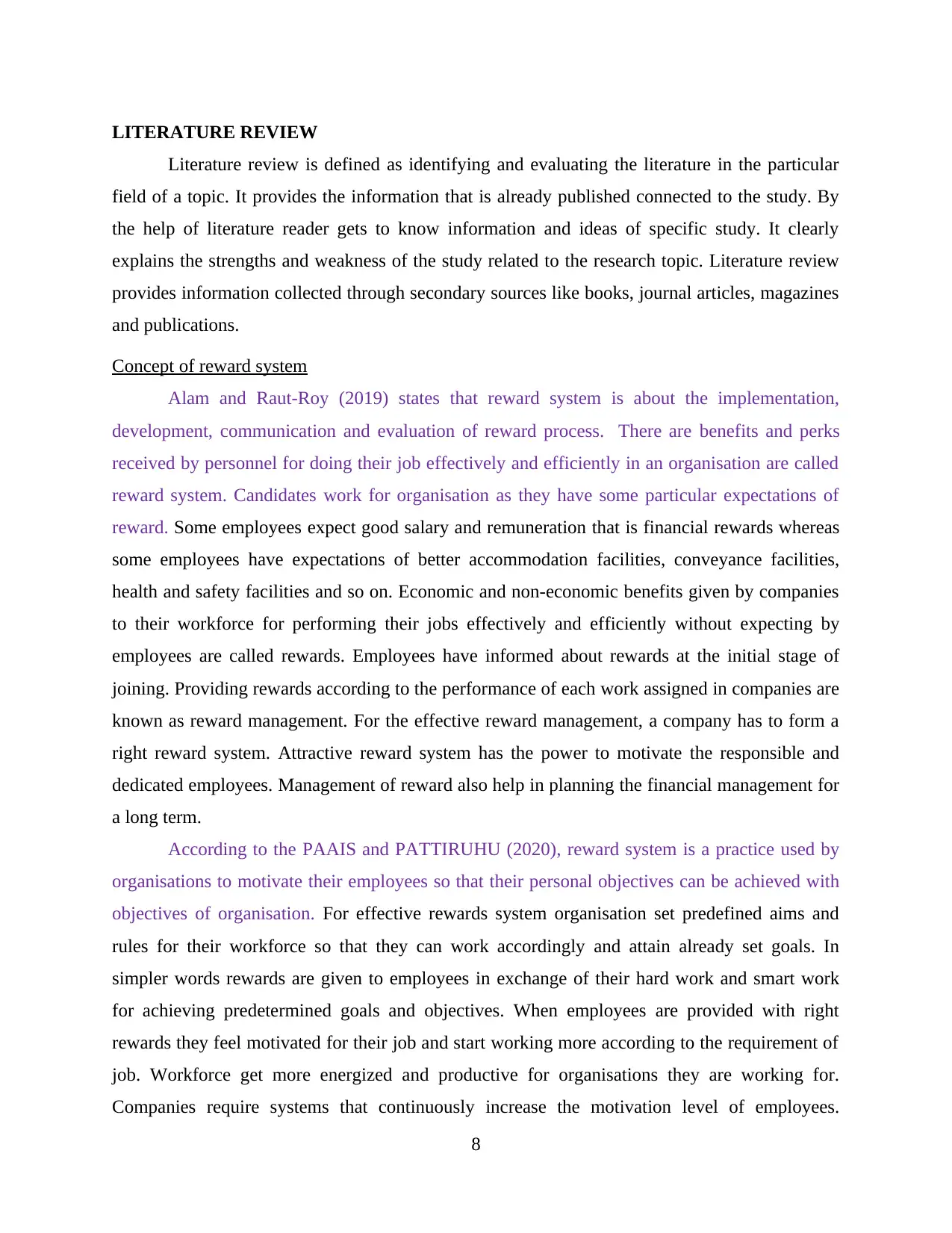
LITERATURE REVIEW
Literature review is defined as identifying and evaluating the literature in the particular
field of a topic. It provides the information that is already published connected to the study. By
the help of literature reader gets to know information and ideas of specific study. It clearly
explains the strengths and weakness of the study related to the research topic. Literature review
provides information collected through secondary sources like books, journal articles, magazines
and publications.
Concept of reward system
Alam and Raut-Roy (2019) states that reward system is about the implementation,
development, communication and evaluation of reward process. There are benefits and perks
received by personnel for doing their job effectively and efficiently in an organisation are called
reward system. Candidates work for organisation as they have some particular expectations of
reward. Some employees expect good salary and remuneration that is financial rewards whereas
some employees have expectations of better accommodation facilities, conveyance facilities,
health and safety facilities and so on. Economic and non-economic benefits given by companies
to their workforce for performing their jobs effectively and efficiently without expecting by
employees are called rewards. Employees have informed about rewards at the initial stage of
joining. Providing rewards according to the performance of each work assigned in companies are
known as reward management. For the effective reward management, a company has to form a
right reward system. Attractive reward system has the power to motivate the responsible and
dedicated employees. Management of reward also help in planning the financial management for
a long term.
According to the PAAIS and PATTIRUHU (2020), reward system is a practice used by
organisations to motivate their employees so that their personal objectives can be achieved with
objectives of organisation. For effective rewards system organisation set predefined aims and
rules for their workforce so that they can work accordingly and attain already set goals. In
simpler words rewards are given to employees in exchange of their hard work and smart work
for achieving predetermined goals and objectives. When employees are provided with right
rewards they feel motivated for their job and start working more according to the requirement of
job. Workforce get more energized and productive for organisations they are working for.
Companies require systems that continuously increase the motivation level of employees.
8
Literature review is defined as identifying and evaluating the literature in the particular
field of a topic. It provides the information that is already published connected to the study. By
the help of literature reader gets to know information and ideas of specific study. It clearly
explains the strengths and weakness of the study related to the research topic. Literature review
provides information collected through secondary sources like books, journal articles, magazines
and publications.
Concept of reward system
Alam and Raut-Roy (2019) states that reward system is about the implementation,
development, communication and evaluation of reward process. There are benefits and perks
received by personnel for doing their job effectively and efficiently in an organisation are called
reward system. Candidates work for organisation as they have some particular expectations of
reward. Some employees expect good salary and remuneration that is financial rewards whereas
some employees have expectations of better accommodation facilities, conveyance facilities,
health and safety facilities and so on. Economic and non-economic benefits given by companies
to their workforce for performing their jobs effectively and efficiently without expecting by
employees are called rewards. Employees have informed about rewards at the initial stage of
joining. Providing rewards according to the performance of each work assigned in companies are
known as reward management. For the effective reward management, a company has to form a
right reward system. Attractive reward system has the power to motivate the responsible and
dedicated employees. Management of reward also help in planning the financial management for
a long term.
According to the PAAIS and PATTIRUHU (2020), reward system is a practice used by
organisations to motivate their employees so that their personal objectives can be achieved with
objectives of organisation. For effective rewards system organisation set predefined aims and
rules for their workforce so that they can work accordingly and attain already set goals. In
simpler words rewards are given to employees in exchange of their hard work and smart work
for achieving predetermined goals and objectives. When employees are provided with right
rewards they feel motivated for their job and start working more according to the requirement of
job. Workforce get more energized and productive for organisations they are working for.
Companies require systems that continuously increase the motivation level of employees.
8
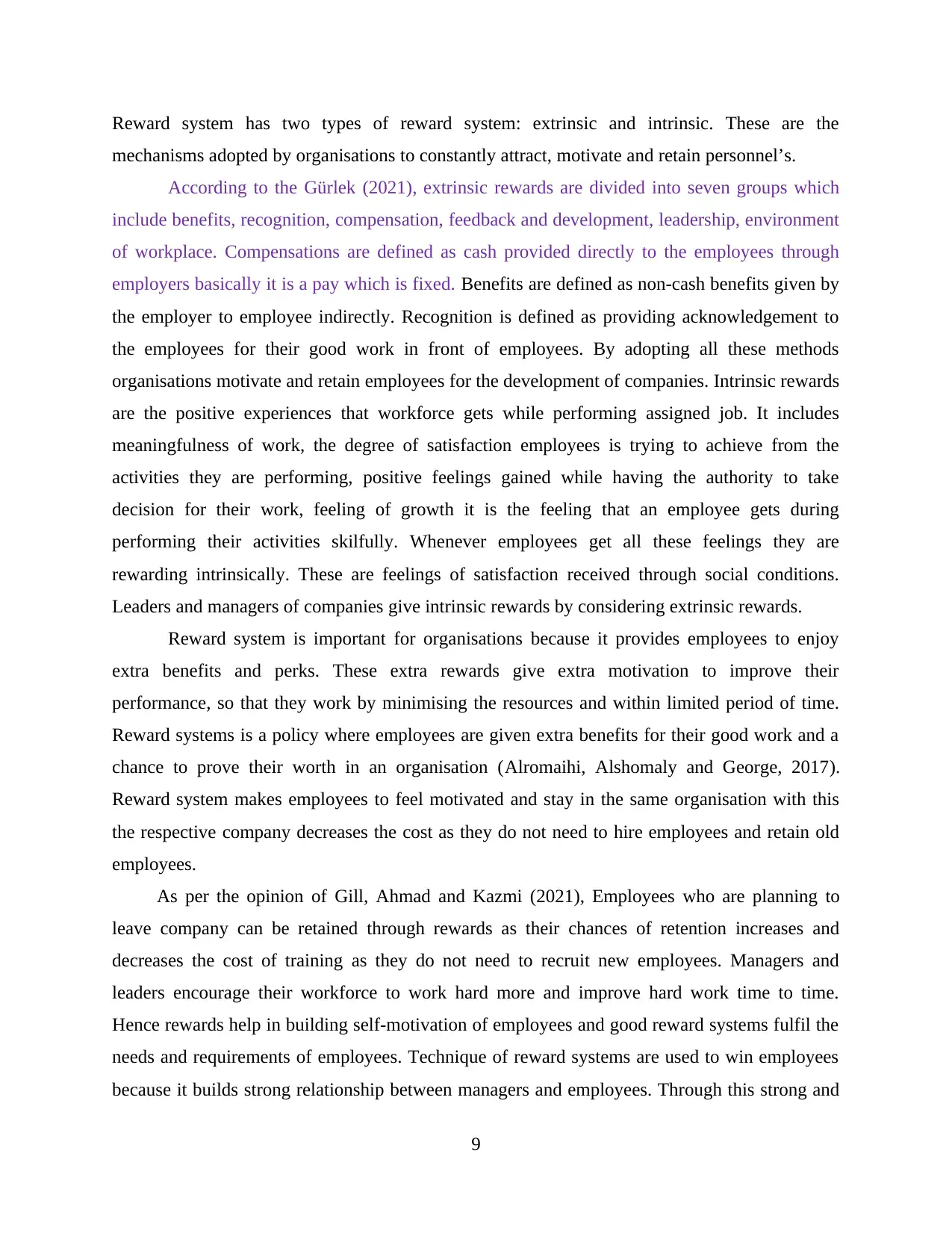
Reward system has two types of reward system: extrinsic and intrinsic. These are the
mechanisms adopted by organisations to constantly attract, motivate and retain personnel’s.
According to the Gürlek (2021), extrinsic rewards are divided into seven groups which
include benefits, recognition, compensation, feedback and development, leadership, environment
of workplace. Compensations are defined as cash provided directly to the employees through
employers basically it is a pay which is fixed. Benefits are defined as non-cash benefits given by
the employer to employee indirectly. Recognition is defined as providing acknowledgement to
the employees for their good work in front of employees. By adopting all these methods
organisations motivate and retain employees for the development of companies. Intrinsic rewards
are the positive experiences that workforce gets while performing assigned job. It includes
meaningfulness of work, the degree of satisfaction employees is trying to achieve from the
activities they are performing, positive feelings gained while having the authority to take
decision for their work, feeling of growth it is the feeling that an employee gets during
performing their activities skilfully. Whenever employees get all these feelings they are
rewarding intrinsically. These are feelings of satisfaction received through social conditions.
Leaders and managers of companies give intrinsic rewards by considering extrinsic rewards.
Reward system is important for organisations because it provides employees to enjoy
extra benefits and perks. These extra rewards give extra motivation to improve their
performance, so that they work by minimising the resources and within limited period of time.
Reward systems is a policy where employees are given extra benefits for their good work and a
chance to prove their worth in an organisation (Alromaihi, Alshomaly and George, 2017).
Reward system makes employees to feel motivated and stay in the same organisation with this
the respective company decreases the cost as they do not need to hire employees and retain old
employees.
As per the opinion of Gill, Ahmad and Kazmi (2021), Employees who are planning to
leave company can be retained through rewards as their chances of retention increases and
decreases the cost of training as they do not need to recruit new employees. Managers and
leaders encourage their workforce to work hard more and improve hard work time to time.
Hence rewards help in building self-motivation of employees and good reward systems fulfil the
needs and requirements of employees. Technique of reward systems are used to win employees
because it builds strong relationship between managers and employees. Through this strong and
9
mechanisms adopted by organisations to constantly attract, motivate and retain personnel’s.
According to the Gürlek (2021), extrinsic rewards are divided into seven groups which
include benefits, recognition, compensation, feedback and development, leadership, environment
of workplace. Compensations are defined as cash provided directly to the employees through
employers basically it is a pay which is fixed. Benefits are defined as non-cash benefits given by
the employer to employee indirectly. Recognition is defined as providing acknowledgement to
the employees for their good work in front of employees. By adopting all these methods
organisations motivate and retain employees for the development of companies. Intrinsic rewards
are the positive experiences that workforce gets while performing assigned job. It includes
meaningfulness of work, the degree of satisfaction employees is trying to achieve from the
activities they are performing, positive feelings gained while having the authority to take
decision for their work, feeling of growth it is the feeling that an employee gets during
performing their activities skilfully. Whenever employees get all these feelings they are
rewarding intrinsically. These are feelings of satisfaction received through social conditions.
Leaders and managers of companies give intrinsic rewards by considering extrinsic rewards.
Reward system is important for organisations because it provides employees to enjoy
extra benefits and perks. These extra rewards give extra motivation to improve their
performance, so that they work by minimising the resources and within limited period of time.
Reward systems is a policy where employees are given extra benefits for their good work and a
chance to prove their worth in an organisation (Alromaihi, Alshomaly and George, 2017).
Reward system makes employees to feel motivated and stay in the same organisation with this
the respective company decreases the cost as they do not need to hire employees and retain old
employees.
As per the opinion of Gill, Ahmad and Kazmi (2021), Employees who are planning to
leave company can be retained through rewards as their chances of retention increases and
decreases the cost of training as they do not need to recruit new employees. Managers and
leaders encourage their workforce to work hard more and improve hard work time to time.
Hence rewards help in building self-motivation of employees and good reward systems fulfil the
needs and requirements of employees. Technique of reward systems are used to win employees
because it builds strong relationship between managers and employees. Through this strong and
9
⊘ This is a preview!⊘
Do you want full access?
Subscribe today to unlock all pages.

Trusted by 1+ million students worldwide
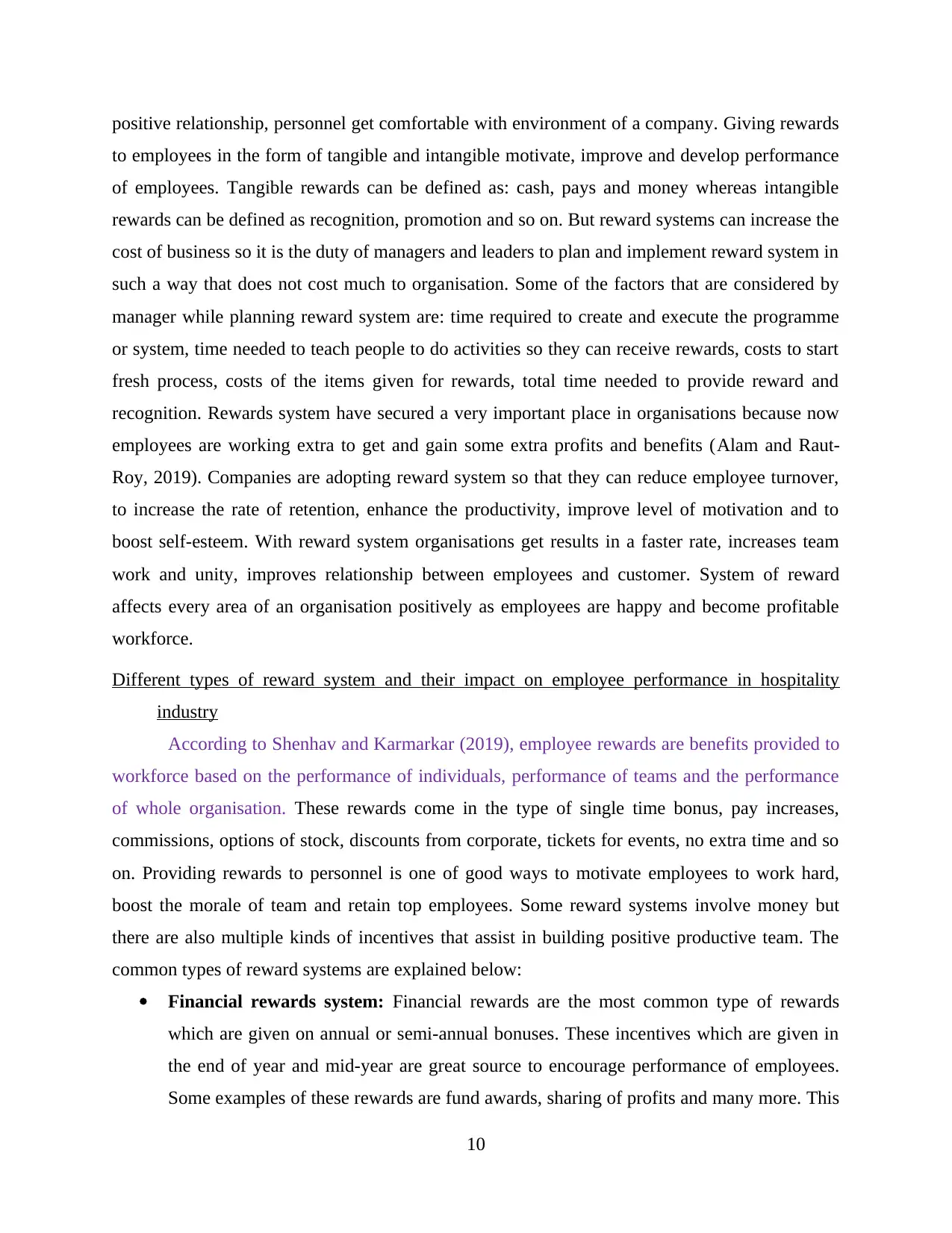
positive relationship, personnel get comfortable with environment of a company. Giving rewards
to employees in the form of tangible and intangible motivate, improve and develop performance
of employees. Tangible rewards can be defined as: cash, pays and money whereas intangible
rewards can be defined as recognition, promotion and so on. But reward systems can increase the
cost of business so it is the duty of managers and leaders to plan and implement reward system in
such a way that does not cost much to organisation. Some of the factors that are considered by
manager while planning reward system are: time required to create and execute the programme
or system, time needed to teach people to do activities so they can receive rewards, costs to start
fresh process, costs of the items given for rewards, total time needed to provide reward and
recognition. Rewards system have secured a very important place in organisations because now
employees are working extra to get and gain some extra profits and benefits (Alam and Raut-
Roy, 2019). Companies are adopting reward system so that they can reduce employee turnover,
to increase the rate of retention, enhance the productivity, improve level of motivation and to
boost self-esteem. With reward system organisations get results in a faster rate, increases team
work and unity, improves relationship between employees and customer. System of reward
affects every area of an organisation positively as employees are happy and become profitable
workforce.
Different types of reward system and their impact on employee performance in hospitality
industry
According to Shenhav and Karmarkar (2019), employee rewards are benefits provided to
workforce based on the performance of individuals, performance of teams and the performance
of whole organisation. These rewards come in the type of single time bonus, pay increases,
commissions, options of stock, discounts from corporate, tickets for events, no extra time and so
on. Providing rewards to personnel is one of good ways to motivate employees to work hard,
boost the morale of team and retain top employees. Some reward systems involve money but
there are also multiple kinds of incentives that assist in building positive productive team. The
common types of reward systems are explained below:
Financial rewards system: Financial rewards are the most common type of rewards
which are given on annual or semi-annual bonuses. These incentives which are given in
the end of year and mid-year are great source to encourage performance of employees.
Some examples of these rewards are fund awards, sharing of profits and many more. This
10
to employees in the form of tangible and intangible motivate, improve and develop performance
of employees. Tangible rewards can be defined as: cash, pays and money whereas intangible
rewards can be defined as recognition, promotion and so on. But reward systems can increase the
cost of business so it is the duty of managers and leaders to plan and implement reward system in
such a way that does not cost much to organisation. Some of the factors that are considered by
manager while planning reward system are: time required to create and execute the programme
or system, time needed to teach people to do activities so they can receive rewards, costs to start
fresh process, costs of the items given for rewards, total time needed to provide reward and
recognition. Rewards system have secured a very important place in organisations because now
employees are working extra to get and gain some extra profits and benefits (Alam and Raut-
Roy, 2019). Companies are adopting reward system so that they can reduce employee turnover,
to increase the rate of retention, enhance the productivity, improve level of motivation and to
boost self-esteem. With reward system organisations get results in a faster rate, increases team
work and unity, improves relationship between employees and customer. System of reward
affects every area of an organisation positively as employees are happy and become profitable
workforce.
Different types of reward system and their impact on employee performance in hospitality
industry
According to Shenhav and Karmarkar (2019), employee rewards are benefits provided to
workforce based on the performance of individuals, performance of teams and the performance
of whole organisation. These rewards come in the type of single time bonus, pay increases,
commissions, options of stock, discounts from corporate, tickets for events, no extra time and so
on. Providing rewards to personnel is one of good ways to motivate employees to work hard,
boost the morale of team and retain top employees. Some reward systems involve money but
there are also multiple kinds of incentives that assist in building positive productive team. The
common types of reward systems are explained below:
Financial rewards system: Financial rewards are the most common type of rewards
which are given on annual or semi-annual bonuses. These incentives which are given in
the end of year and mid-year are great source to encourage performance of employees.
Some examples of these rewards are fund awards, sharing of profits and many more. This
10
Paraphrase This Document
Need a fresh take? Get an instant paraphrase of this document with our AI Paraphraser
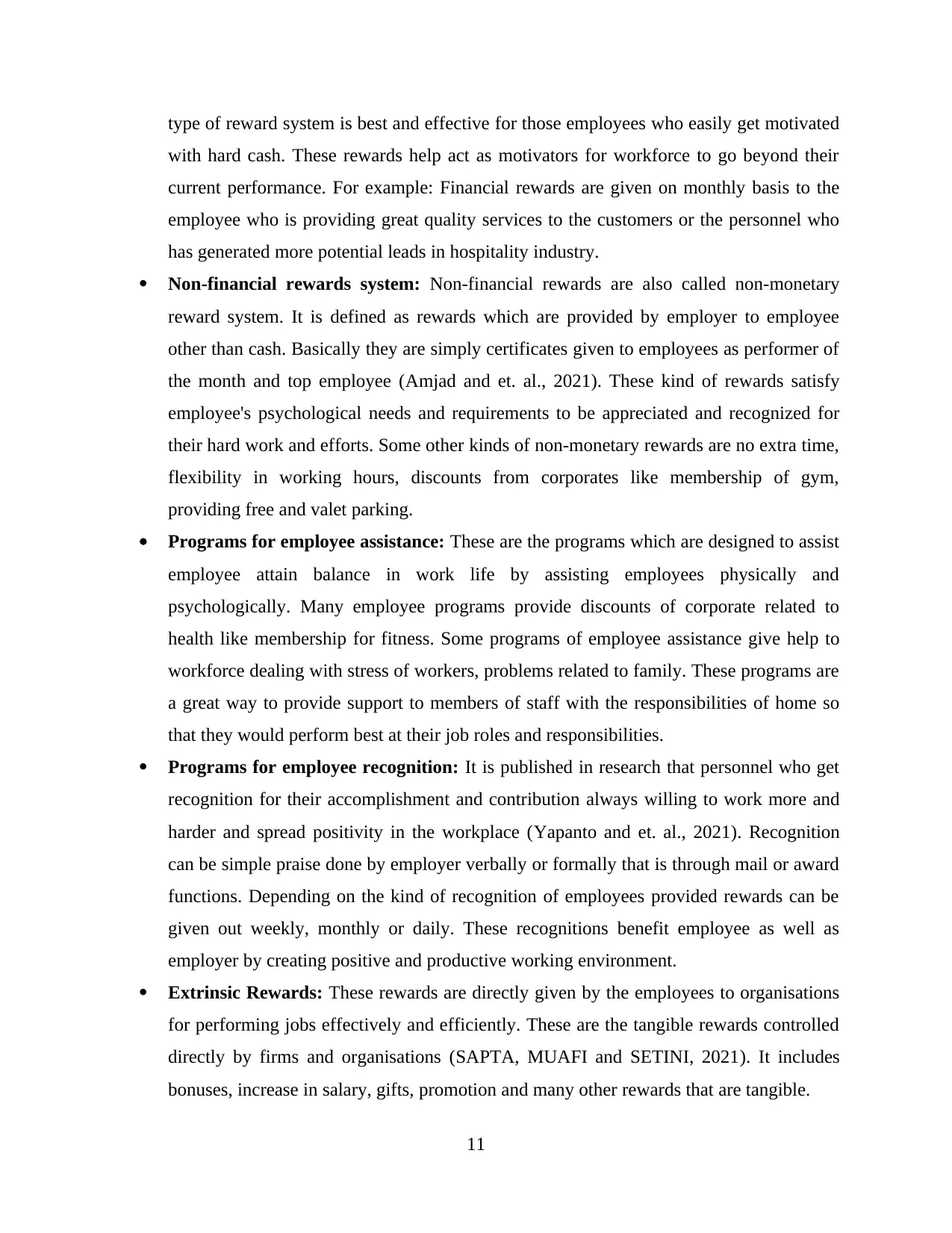
type of reward system is best and effective for those employees who easily get motivated
with hard cash. These rewards help act as motivators for workforce to go beyond their
current performance. For example: Financial rewards are given on monthly basis to the
employee who is providing great quality services to the customers or the personnel who
has generated more potential leads in hospitality industry.
Non-financial rewards system: Non-financial rewards are also called non-monetary
reward system. It is defined as rewards which are provided by employer to employee
other than cash. Basically they are simply certificates given to employees as performer of
the month and top employee (Amjad and et. al., 2021). These kind of rewards satisfy
employee's psychological needs and requirements to be appreciated and recognized for
their hard work and efforts. Some other kinds of non-monetary rewards are no extra time,
flexibility in working hours, discounts from corporates like membership of gym,
providing free and valet parking.
Programs for employee assistance: These are the programs which are designed to assist
employee attain balance in work life by assisting employees physically and
psychologically. Many employee programs provide discounts of corporate related to
health like membership for fitness. Some programs of employee assistance give help to
workforce dealing with stress of workers, problems related to family. These programs are
a great way to provide support to members of staff with the responsibilities of home so
that they would perform best at their job roles and responsibilities.
Programs for employee recognition: It is published in research that personnel who get
recognition for their accomplishment and contribution always willing to work more and
harder and spread positivity in the workplace (Yapanto and et. al., 2021). Recognition
can be simple praise done by employer verbally or formally that is through mail or award
functions. Depending on the kind of recognition of employees provided rewards can be
given out weekly, monthly or daily. These recognitions benefit employee as well as
employer by creating positive and productive working environment.
Extrinsic Rewards: These rewards are directly given by the employees to organisations
for performing jobs effectively and efficiently. These are the tangible rewards controlled
directly by firms and organisations (SAPTA, MUAFI and SETINI, 2021). It includes
bonuses, increase in salary, gifts, promotion and many other rewards that are tangible.
11
with hard cash. These rewards help act as motivators for workforce to go beyond their
current performance. For example: Financial rewards are given on monthly basis to the
employee who is providing great quality services to the customers or the personnel who
has generated more potential leads in hospitality industry.
Non-financial rewards system: Non-financial rewards are also called non-monetary
reward system. It is defined as rewards which are provided by employer to employee
other than cash. Basically they are simply certificates given to employees as performer of
the month and top employee (Amjad and et. al., 2021). These kind of rewards satisfy
employee's psychological needs and requirements to be appreciated and recognized for
their hard work and efforts. Some other kinds of non-monetary rewards are no extra time,
flexibility in working hours, discounts from corporates like membership of gym,
providing free and valet parking.
Programs for employee assistance: These are the programs which are designed to assist
employee attain balance in work life by assisting employees physically and
psychologically. Many employee programs provide discounts of corporate related to
health like membership for fitness. Some programs of employee assistance give help to
workforce dealing with stress of workers, problems related to family. These programs are
a great way to provide support to members of staff with the responsibilities of home so
that they would perform best at their job roles and responsibilities.
Programs for employee recognition: It is published in research that personnel who get
recognition for their accomplishment and contribution always willing to work more and
harder and spread positivity in the workplace (Yapanto and et. al., 2021). Recognition
can be simple praise done by employer verbally or formally that is through mail or award
functions. Depending on the kind of recognition of employees provided rewards can be
given out weekly, monthly or daily. These recognitions benefit employee as well as
employer by creating positive and productive working environment.
Extrinsic Rewards: These rewards are directly given by the employees to organisations
for performing jobs effectively and efficiently. These are the tangible rewards controlled
directly by firms and organisations (SAPTA, MUAFI and SETINI, 2021). It includes
bonuses, increase in salary, gifts, promotion and many other rewards that are tangible.
11
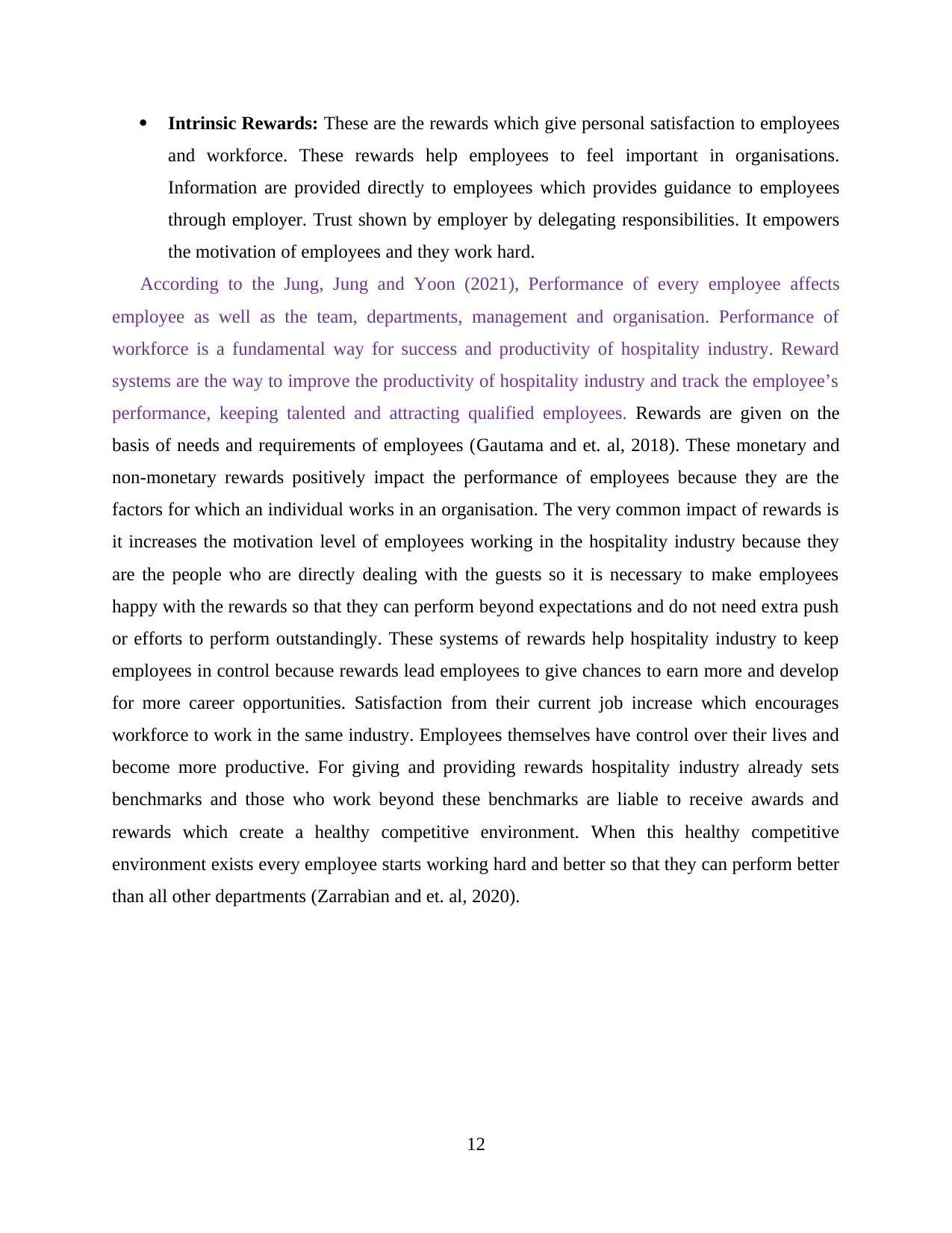
Intrinsic Rewards: These are the rewards which give personal satisfaction to employees
and workforce. These rewards help employees to feel important in organisations.
Information are provided directly to employees which provides guidance to employees
through employer. Trust shown by employer by delegating responsibilities. It empowers
the motivation of employees and they work hard.
According to the Jung, Jung and Yoon (2021), Performance of every employee affects
employee as well as the team, departments, management and organisation. Performance of
workforce is a fundamental way for success and productivity of hospitality industry. Reward
systems are the way to improve the productivity of hospitality industry and track the employee’s
performance, keeping talented and attracting qualified employees. Rewards are given on the
basis of needs and requirements of employees (Gautama and et. al, 2018). These monetary and
non-monetary rewards positively impact the performance of employees because they are the
factors for which an individual works in an organisation. The very common impact of rewards is
it increases the motivation level of employees working in the hospitality industry because they
are the people who are directly dealing with the guests so it is necessary to make employees
happy with the rewards so that they can perform beyond expectations and do not need extra push
or efforts to perform outstandingly. These systems of rewards help hospitality industry to keep
employees in control because rewards lead employees to give chances to earn more and develop
for more career opportunities. Satisfaction from their current job increase which encourages
workforce to work in the same industry. Employees themselves have control over their lives and
become more productive. For giving and providing rewards hospitality industry already sets
benchmarks and those who work beyond these benchmarks are liable to receive awards and
rewards which create a healthy competitive environment. When this healthy competitive
environment exists every employee starts working hard and better so that they can perform better
than all other departments (Zarrabian and et. al, 2020).
12
and workforce. These rewards help employees to feel important in organisations.
Information are provided directly to employees which provides guidance to employees
through employer. Trust shown by employer by delegating responsibilities. It empowers
the motivation of employees and they work hard.
According to the Jung, Jung and Yoon (2021), Performance of every employee affects
employee as well as the team, departments, management and organisation. Performance of
workforce is a fundamental way for success and productivity of hospitality industry. Reward
systems are the way to improve the productivity of hospitality industry and track the employee’s
performance, keeping talented and attracting qualified employees. Rewards are given on the
basis of needs and requirements of employees (Gautama and et. al, 2018). These monetary and
non-monetary rewards positively impact the performance of employees because they are the
factors for which an individual works in an organisation. The very common impact of rewards is
it increases the motivation level of employees working in the hospitality industry because they
are the people who are directly dealing with the guests so it is necessary to make employees
happy with the rewards so that they can perform beyond expectations and do not need extra push
or efforts to perform outstandingly. These systems of rewards help hospitality industry to keep
employees in control because rewards lead employees to give chances to earn more and develop
for more career opportunities. Satisfaction from their current job increase which encourages
workforce to work in the same industry. Employees themselves have control over their lives and
become more productive. For giving and providing rewards hospitality industry already sets
benchmarks and those who work beyond these benchmarks are liable to receive awards and
rewards which create a healthy competitive environment. When this healthy competitive
environment exists every employee starts working hard and better so that they can perform better
than all other departments (Zarrabian and et. al, 2020).
12
⊘ This is a preview!⊘
Do you want full access?
Subscribe today to unlock all pages.

Trusted by 1+ million students worldwide
1 out of 46
Related Documents
Your All-in-One AI-Powered Toolkit for Academic Success.
+13062052269
info@desklib.com
Available 24*7 on WhatsApp / Email
![[object Object]](/_next/static/media/star-bottom.7253800d.svg)
Unlock your academic potential
Copyright © 2020–2025 A2Z Services. All Rights Reserved. Developed and managed by ZUCOL.





